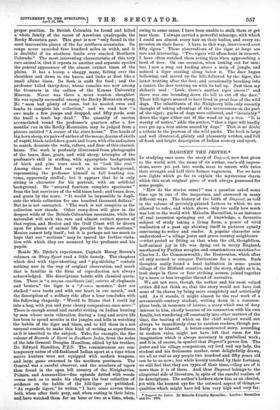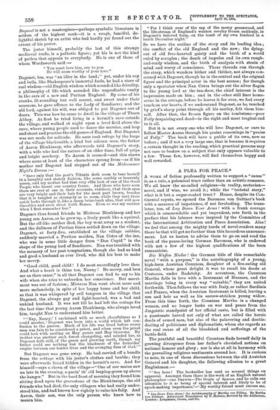DAGONET THE JESTER.* IN studying once more the story of
Dagonet, now first given to the world with the name of its author, one's old impres- sions, never yet put into words, seem to return with twice their strength and half their former vagueness. For we have new lights which go far to explain the mysterious charm which this most original piece of work always possessed for some people.
"How do the stories comer" was a question asked some time ago in one of the magazines, and answered in many different ways. The history of the birth of Dagonet, as told in the volume of privately printed Letters to which we are allowed to refer, and which shows only too sadly how much was lost to the world with Malcolm Macmillan, is an instance of real invention springing out of knowledge, a favourite subject of study taking a living form, a power of vivid realisation of a past age showing itself in pictures equally convincing to writer and reader. A popular character mis- understood—" a village jester and grave country neighbours —what period so fitting as that when the old, thoughtless, half-animal joy in life was dying out in merry England, smothered by Puritan scruples and conscientious anxieties ?— Charles I., the Commonwealth; the Restoration, which after all only seemed to conquer Puritanism for a season. Such thoughts easily found a local habitation in some quaint village of the Midland counties, and the story, slight as it is, took shape in three or four striking scenes, joined together by a more or less irregular thread of narrative.
We are not sure, though the author and his most valued critics did not think so, that the story would not have lost some of its charm by being more completely and artistically told. As it stands, it might almost be the real work of a seventeenth-century student, writing down in a common- place book, in moments of leisure, a story which was of deep interest to him, chiefly because of its connection with his own family, but wandering off constantly into other matters of the time, the bearing of which on the chief subject would not always be immediately clear to careless readers, though per- fectly so to himself. A better-constructed story, according to modern rules, might not have left that room for the imagination which is always necessary in symbolical work ; and it is, of course, in symbol that Dagonet's power lies. The jester and his village companions, my lord and my lady, the student and his frolicsome mother, most delightfully drawn, are all as real as any people two hundred and fifty years old can be to us now; but while keenly touched by their fortunes, we still feel that they are types of their time,—they are of it more than it is of them. And thus Dagonet belongs to the allegorical side of literature, in spite of the careful realism of its descriptions. The author's Letters show him as an idealist, yet with the keenest eye for the outward aspect of things,— qualities which might have led him very high and very far.
• Dagonet the Jester. By Malcolm Kingsley Macmillan. London ; Macmillan and Co. 1894. Dagonet is not a masterpiece—perhaps symbolic literature is seldom of the highest rank—it is a rough, fanciful, de- lightful sketch by an artist who had hardly yet found out the extent of his power.
The jester himself, probably the last of this strange media3val trade, is a pathetic figure ; yet his is not the kind of pathos that appeals to everybody. He is one of those of whom Wordsworth said :-
" You must love him, ere to you
He will seem worthy of your love."
Dagonet, too, was "an idler in the land ;" yet, under his cap and bells, like Shakespeare's immortal fools, he had a store of real wisdom—old English wisdom which sounded like frivolity, a philosophy of life which sounded like unprofitable vanity in the ears of a new and Puritan England. By some of his cranks, ill-sounding but well meant, and sweet under their sourness, he gave offence to the Lady of Sandiacre; and the old lord, against his will, was obliged to put Dagonet out of doors. This was how he came to dwell in the village of Thorn Abbey. At first he tried living in a hermit's cave outside the village, and walked at night upon a level field above the cave, where young people used to dance the morrice, and leap and shoot and practise the old games of England. But Dagonet was not made for solitude. He soon took ref age by the forge of the village blacksmith, a kind but solemn man, the father of Aaron Blenkinsop, who afterwards told Dagonet's story, with a wife who had the nature of an older time, full of quips and bright mockery. To Aaron it seemed—and this shows where some at least of the characters sprang from—as if his mother and Dagonet had stepped out of the Midsummer Night's Dream, :- " Save only that the poet's Titania doth seem to bear herself in a haughty and stately fashion, like some earthly or heavenly queen, and my mother had that very elfin look of one of the Good People who haunt our country farms. And those who have seen them are ever at one in their accounts, videlicet, that their eyes are very bright and their hair for the most part brown, besides that it is tangled so strangely as to seem, while they dart their quick looks through it. like a damp briar-bush afire, that will now smoulder and anon shoot forth flames. Even so was my mother when I first remember her."
Dagonet thus found friends in Mistress Blenkinsop and her young son Aaron, as he grew up, a lively youth like a squirrel. But the elf-like mother died, the boy went away as a student, and the dullness of Puritan times settled down on the village. Dagonet, at forty-five, established as the village cobbler, suddenly married a Puritan maiden, Nan Cotes of the inn, who was in some little danger from "Dan Cupid" in the shape of the young lord of Sandiacre. Nan was troubled with the memory of her past temptations, though she had as kind and good a husband as ever lived, who did his best to make her merry.
"Good child, good child ! I do most exceedingly love thee. And what a heart is thine too, Nanny ! Be merry, and love me as thou canst," is all that Dagonet can find to say to his wife when she tries to unburden her conscience. But merri- ment was out of fashion ; Mistress Nan went about more and more melancholy, in spite of her happy home and her child. so that it was whispered by evil tongues in the village that Dagonet, the always gay and light-hearted, was a bad and unkind husband. It was not till he had left the cottage for the last time that young Aaron Blenkinsop, who always loved him, taught Nan to understand him better.
"'Nay, Nancy,' I exclaimed with as much cheerfulness as I could muster, Dagonet was born into a world which left con- fession to the parson. Much of his life was lived before every man was fain to be considered a priest, and when even the priest could look with smiling on May games and May blossoms. My mother was another such forest changeling, and minded her, as Dagonet doth still, of the green and growing earth, though my father could see nothing but the blackness of the Ironsides' empire between our tender lives and the avenging fires of God."
But Dagonet was gone away. He had carried off a bundle
from the cottage with his jester's clothes and bauble ; they were afterwards found hidden in the hermit's cave. And for himself—says a clown of the village—" One of our mates saw un late in the evening, a-pacin' th' old leaping-green up above the hanger." But in the hard frost of morning they found him sitting dead upon the gravestone of the Blenkinsops, the old friends who had died, the only villagers who had really under- stood him, and had known how rightly to value his folly. And Aaron, their son, was the only person who knew how to mourn him. _ " For I think ever of the sap of the merry greenwood, and the life-stream of England's wanton revelry frozen suddenly, in Dagonet's beloved form, . on the tomb of my own kindred in a harsh December night."
So we have the outline of the story and its leading idea; the conflict of the old England and the new; the dying- out of old free-hearted gaiety and the birth of a world ruled by scruples ; the death of impulse and its own rough- and-ready wisdom, and the birth of analysis with strain of mind and worry of conscience. These threads run through the story, which wanders hither and thither, not always con- cerned with Dagonet, though he is the central and the original figure and the principal actor in the best scenes ; for though only a spectator when Nan Cotes brings out the silver flagon to the young lord at the inn-door, the chief interest is the impression made on him ; and in the other still finer home- scene in the cottage, before he leaves it for ever, we feel every touch on our hearts, if we understand Dagonet, as he, touched by grief's sharp point through all his motley, felt them him- self. After that, the frozen figure on the tombstone—poor Folly despairing and dead—is the right and most tragical end to it all.
But it is not every one who will love Dagonet, or care to
follow Master Aaron through his quaint reasonings in "praise of Folly." The book will have a public of its own, now as before ; and if not a very large one, that is because it requires a certain thought in the reading, which practical persons may not care to bestow on a subject that only appears valuable to a few. Those few, however, will find themselves happy and well rewarded.



















































 Previous page
Previous page